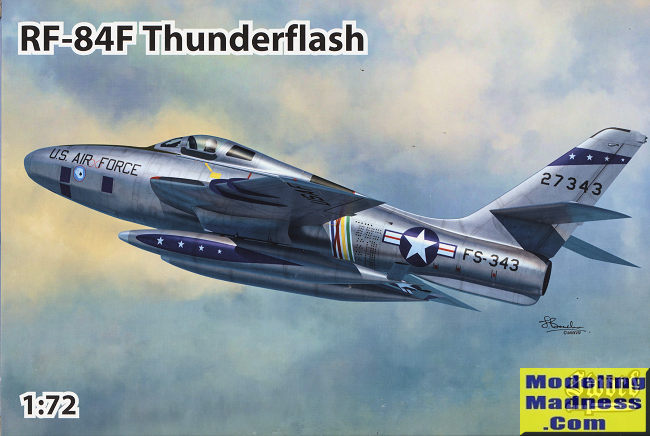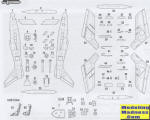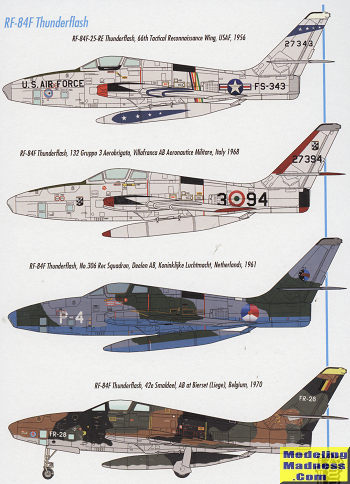
Sword 1/72 RF-84F Thunderflash
| KIT #: | SW 72116 |
| PRICE: | 2430 yen |
| DECALS: | Four options |
| REVIEWER: | Scott Van Aken |
| NOTES: | 2018 tooling |

| HISTORY |
The second YF-84F prototype was completed with wing-root air intakes. These were not adopted for the fighter due to loss of thrust. However, this arrangement permitted placement of cameras in the nose and the design was adopted for the RF-84F Thunderflash reconnaissance version. The first YRF-84F was completed in February 1952. The aircraft retained an armament of four machine guns and could carry up to fifteen cameras. Innovations included computerized controls which adjusted camera settings for light, speed, and altitude, a periscope to give the pilot better visualization of the target, and a voice recorder to let the pilot narrate his observations. Being largely identical to the F-84F, the Thunderflash suffered from the same production delays and engine problems, delaying operational service until March 1954. The aircraft was retired from active duty in 1957, only to be reactivated in 1961, and finally retired from the ANG in 1972. Several modified Thunderflashes were used in the FICON project.
Like the Thunderjet, and Thunderstreak, the RF-84F saw widespread use amongst NATO and other friendly nations that needed a dedicated tactical reconnaissance aircraft. Greece was the last nation to use the F-84, retiring their Thunderflashes in 1991.
| THE KIT |
 Those
familiar with Sword's kits will see that this is very much like their previous
offerings in terms of molding. It is a modern short run kit with excellent
surface detailing and the need to test fit everything prior to applying cement.
Those
familiar with Sword's kits will see that this is very much like their previous
offerings in terms of molding. It is a modern short run kit with excellent
surface detailing and the need to test fit everything prior to applying cement.
The kit's cockpit is well apportioned for the type
with raised instrument and console detail. The kit provides two different seats,
the only items in resin, though it doesn't really tell you which is appropriate.
One will have to do some research in this area. There are no cameras for the
nose, but one does have lens faces so that you will see something through the
transparencies. The kit will probably need a bit of nose weight, though it does
have a rather long wheelbase.

Wings are an upper and lower half on each side with a semblance of intake interior detail. A front and a rear compressor face are provided for the intake and the exhaust. Wing fences are separate items. Landing gear legs are well done with the nose gear incorporating the wheel. Main gear have separate oleo scissors. The main gear doors are three separate pieces. Earlier kits by Airfix and Italeri have these molded onto the gear so this is a nice touch. You are provided inner wing pylons and two large fuel tanks. The canopy and windscreen are separate items so you can pose the canopy open if you wish.
Instructions are well done with a comprehensive
stencil placement guide. The four markings options are provided in full color
and p rovide
two natural metal options for the 66th TRW (the box art plane) and 132 Gruppo
(Italy). In their standard three color camouflage of the time is a Dutch plane
from 306 squadron and an SEA camouflage plane from 42 Squadron, Belgian Air
Force. The decal sheet is quite large, thanks to all the stencils, and very
nicely printed.
rovide
two natural metal options for the 66th TRW (the box art plane) and 132 Gruppo
(Italy). In their standard three color camouflage of the time is a Dutch plane
from 306 squadron and an SEA camouflage plane from 42 Squadron, Belgian Air
Force. The decal sheet is quite large, thanks to all the stencils, and very
nicely printed.
| CONCLUSIONS |
Not the first RF-84F to have been kitted, but a nice one with several nice markings options. This is one of two boxings the other being identical other than the markings options. I would not be surprised if there were a third. While I ordered this one from Japan to help fill an order, it is readily available from various sellers for about the same price.
| REFERENCES |
https://en.wikipedia.org/wiki/Republic_F-84F_Thunderstreak
October 2018
Copyright ModelingMadness.com. All rights reserved.
If you would like your product reviewed fairly and fairly quickly, please
contact
the editor or see other details in the
Note to
Contributors. Back to the Main Page
Back to the Review
Index Page
Back to the Previews Index Page